 |
| The Independent Traveler's Newsletter PAGE FOUR |
 |
| The Independent Traveler's Newsletter PAGE FOUR |
|
Featuring le Centre (Part
One) 'French' may be the single word that best describes the feeling that prevails when one is in the Centre of France. This region may well be the most 'French' of all of France. Yes, it is la Vallée des Rois, where French kings, their queens and their mistresses filled the history books with tales of intrigue, politics and unbelievably opulent lifestyles. And the monuments they have left behind for us to enjoy remind us that it will always remain the Valley of the Kings. The great châteaux, drawing scores of tourists, are breathtaking ~ some almost bigger than human scale and nearly too grand to imagine that they were once residences where a semblance of day-to-day life took place. Yet, there they stand, surrounded by sprawling, manicured gardens, bordered by hand-tended forests, straddling or on the banks of wide rivers, and reminding every visitor who enters through their portals that these imposing architectural triumphs were the center of culture, art, literature and the cradle of the French Renaissance. 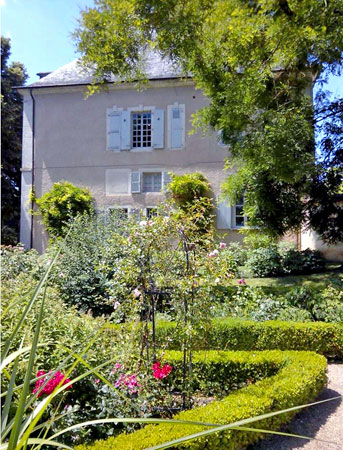 Life went on in smaller manner houses, too, and in the river valleys of the Centre you can still find stately homes once belonging to great names in literature, music and the arts. One such home is that of novelist, George Sand, in the quiet country village of Nohant a few kilometers north of La Châtre. Also known as 'Nohant-Vic', this is the 'village of George Sand'. The Romanesque church of Vic and town square are listed historical sites, as are the XIIth-century church frescoes. Annual events taking place in the town include the Village Festival in July, displaying handicrafts and depicting folklore, and the Romantic Festival (classical concerts) in June. The home of George Sand hosts guided visits today. It is situated in a large park, and behind a high stone wall in a quiet corner of the property is the family cemetery. Most interesting for fans of George Sand's writings is that her novels were all set in the region around Nohant and the larger town of La Châtre. For those who are familiar with some of her writings, the Castle of Motte-Feuilly is where several scenes from Beaux Messieurs de Bois-Doré (Good Gentlemen of Golden Wood) took place, and you may recognize the donjon of Sarzay mentioned in Le Meunier d'Angibault (The Miller of Angibault). A number of her works were translated into English in the 1970s, with a few having been translated in the decades after they were first written. George Sand's presence is felt throughout the region from Château de Châtellier south of Châteauroux to St-Sévère-sur-Indre southwest of La Châtre. She christened the region the 'Vallée Noire' ~ the black valley ~ when she wrote, "Distant landscapes have that pretty blue color that becomes violet and almost black on stormy days." From her books, read the world over, people learned of the places, monuments and beautiful countryside she enjoyed during her years at Nohant. George Sand was born Amantine Aurore Lucile Dupin de Francueil in 1804. After a failed marriage, she began to write to support herself and her two children. Luckier than most, her first novel made her an overnight success. She retreated to her country home at Nohant. In 1836 in Paris she met Frédéric Chopin, and they spent seven years together at Nohant. Here, the frail, tubercular Chopin composed a total of 47 works including sonatas, nocturnes and mazurkas, claiming that George Sand was his inspiration. One of his better-known works, the Waltz in D Flat (the "Minute Waltz"), was written at Nohant for her dog! Their friends, such as Liszt, Delacroix, Flaubert and Balzac, spent time with them at Nohant. Sand and Chopin separated after a quarrel in 1847, and Frédéric Chopin died in Paris at the age of 39 in 1849. George Sand, a feminist, divorcée and political activist defending the new Republic, had a life-long commitment to her writing and to the peasants of Berry who remembered her always as the 'good lady of Nohant'. She died on June 8, 1876 at the age of 71. A six-hectare historical park at Domaine George Sand contains beautiful gardens, an orchard, a vegetable garden and woods. She truly loved Nohant and her Vallée Noire. Fifteen rooms of her lovely home are now a museum, including the large kitchen filled with copper utensils, the Blue Room, and the salon with her piano. Also, quite interesting is the museum on the property which houses, among other things, marionettes that she acquired to entertain her children. Visitors are welcomed . . . it is open almost all year 'round. For detailed information click here. In the town of La Châtre you will find the George Sand et la Vallée Noir Museum, which we enjoyed immensely. There is an entire floor devoted to birds, another to model buildings of all sorts, and as you climb the winding stairway, niches displaying busts of Sand's friends and acquaintances will greet you. Finally, an entire floor is dedicated to her art collection: paintings, etchings and drawings fill the room.  Here in the Indre département (36) the landscape is rolling and verdant an gently crossed by the rivers Indre and Creuse. There is Châteauroux, the second largest town in the province of Berry after Bourges, and known throughout Europe as the 'city in a garden' for its expanisve green areas and colorful flowerbeds. Châteauroux has thus succeeded in harmoniously balancing conservation with modern urbanization, while maintaining the heritage of which its people are so proud. Throughout the Indre département and the Centre itself, gardens are in abundance and open to the public. Near the town of Déols on the Route de Villers you will find the Chénevières Eco-Park, created to take advantage of natural flora and fauna in the wetlands along the banks of the River Indre. It is open daily and there is no admission charge. There is also an arboretum. Château de Valençay has formal gardens with lawns, shrubbery, and flowerbeds and even has an animal park. Lastly, Azay-le-Ferron Château Park with huge topiaries set amid centuries-old trees is well worth a visit. 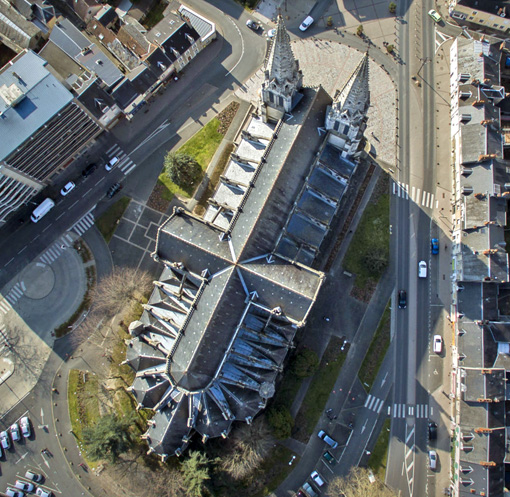 Drone
view of Église Saint-André, Chateauroux
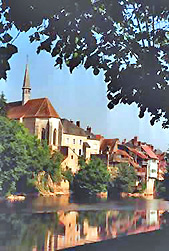 One should try to visit Argenton-sur-Creuse (photo right), if only because it is a photographer's dream. The narrow winding streets are lined with ancient houses, some of which overhang the curve of the River Creuse that you can cross on le Vieux Pont, a medieval bridge. A 6.5 meter high statue of the Virgin Mary, "La Bonne Dame", looks down on the village below from its spot outside the Chapelle Notre Dame des Bancs. It was built to honor a similar small statue above the chapel's altar which it is believed protected the town from the plague of 1632. The département of Cher (18) is at the southeast corner of the six départements that comprise le Centre. Only a few châteaux of the Loire are found in this area. One of the most interesting is Ainay-Le-Vieil in the town of the same name. It has medieval outer walls, but inside is a beautiful Renaissance building. The castle is surrounded by a circular moat, and it is believed that its origins are Gallo-Roman built over in the 12th century. In  1530 a chapel was added with frescoes of the
mother and wife of the owner. In the 17th century, scenes of
Christ's life were added that are quite beautiful. South of
Bourges, the largest city in Cher, is Château Meillant, with a
stair in Flamboyant Gothic style. It was built for
Charles
II d'Amboise before 1510. Earlier parts of the château were
constructed from 1473 to 1481 for Charles I d'Amboise, and there were
19th century additions. The roofline is a series of towers and
chimneys. Inside, you will find an intricately carved altarpiece
and stained glass in the 16th century chapel. 1530 a chapel was added with frescoes of the
mother and wife of the owner. In the 17th century, scenes of
Christ's life were added that are quite beautiful. South of
Bourges, the largest city in Cher, is Château Meillant, with a
stair in Flamboyant Gothic style. It was built for
Charles
II d'Amboise before 1510. Earlier parts of the château were
constructed from 1473 to 1481 for Charles I d'Amboise, and there were
19th century additions. The roofline is a series of towers and
chimneys. Inside, you will find an intricately carved altarpiece
and stained glass in the 16th century chapel.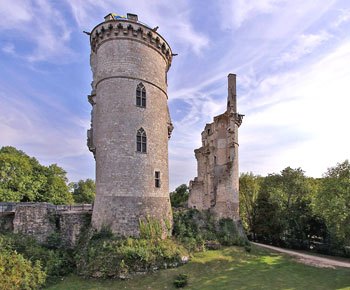 Also in the Cher region, north of Bourges, are the ruins of Mehun-sur-Yèvre castle (photo right) on the River Yèvre in the town of the same name. (Joan of Arc stayed in town at 87, rue Jeanne d'Arc.) Reconstructed by architect Guy de Dammartin between 1367 and 1390, it is believed it once was a massive fort built in the 12th century. Duke Jean de Berry, brother of the King, commissioned a Book of Hours, and one page shows the castle as it once stood in a depiction entitled Christ in the Wilderness. Near Sancerre is Château Boucard, also surrounded by a moat and built over a two hundred year period beginning in the 11th century. It has many impressive fireplaces; the one in the kitchen had a mechanical roasting spit. The château wings clearly depict two different periods of the French Renaissance, one considered François I and the other Renaissance classicism. Of course, the Cher has more to offer than châteaux. One must take care not to overdo the château visits in case one tour blends in with another, and none are well-remembered or appreciated. The Cher's principal town is Bourges and can be seen for miles from any direction because of Cathédrale St-Étienne whose height soars above the city. UNESCO has declared the cathedral a World Heritage Monument. Bourges' history includes being attacked by Caesar's legions when it was known as Avaricum. Louis XI was born in Bourges' palace, and he established the foundation of its university in 1463. Its law school was famous throughout Europe. Bourges is also known for its Maison de la Culture, which is a national music academy, an experimental music center and a fine arts school. Not to be missed is the Palais Jacques-Coeur, commissioned for him when he was Charles VII's Master of the Mint. Bourges also has a large and pleasant pedestrian zone in the center of the town and Place Goudaine where you can enjoy restaurants, theatre and sidewalk cafés. 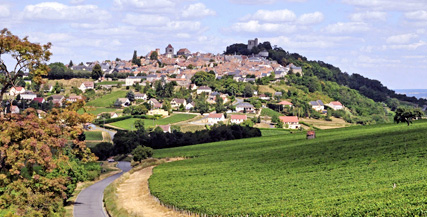 Sancerre, a town primarily known for its wine production, has a great vantage point high above the banks of the Loire. Surrounded by rolling hills covered in vines, Sancerre has a charming old town with plenty of shops selling locally-produced pottery and crafts. The Tour de Fiefs is the 14th-century cylindrical keep ~ all that remains of the Huguenot château of the counts of Sancerre destroyed in the siege of 1573. In the heart of wine country, you will no doubt have many opportunities for dégustation. Nearby in Chavignol is Domaine Henri Bourgeois, about 2 kilometers west of town and now in existence for ten generations! They produce fine white and red Sancerre wines, and also have a restaurant and small hotel, La Côte des Monts Damnée, on Place de l'Orme in Chavignol. Our
next issue will continue with our feature on Le Centre taking you on a
tour of the Indre-et-Loir and Loiret départements.
WHERE TO STAY IN THE CENTRE: In the Loir-et-Cher département consider Château du Breuil and Relais des Trois Châteaux, both very near the royal Château de Cheverny that is open for tours. Also in this département, as mentioned above, just south of Orléans in Theillay, is the beautiful Château de Rère, in a land of dense forest near the border with the Cher département. All three offer bed & breakfast accommodations. Farther west in the Centre is Château de Détilly, a property you can rent by the week and which will comfortably accommodate 27 people ~ and it has tennis courts and a swimming pool. Please visit each of them by clicking on the links provided. SAVING THE OLDEST CHURCH IN PARIS ~ Restoring a Landmark to Last Through the Ages The Church of Saint Germain des Prés ~ the building and its artwork ~ reflects many eras of French history, art and culture. As the oldest church in Paris, standing since the year 543, it has influenced and shaped people, places and ideas throughout history, including the famous philosopher Descartes, and Sorbonne students and teachers. Its architecture is a fascinating compilation of styles, from Romanesque arches and capitals to Gothic elements in the nave and choir. Walking through the church at Saint Germain de Prés is like taking a journey to the past. Every aspect of the church itself is a testament to French culture and history. Unfortunately, it must contend with the ravages of time, and the overall condition of the church has deteriorated steadily throughout the centuries. 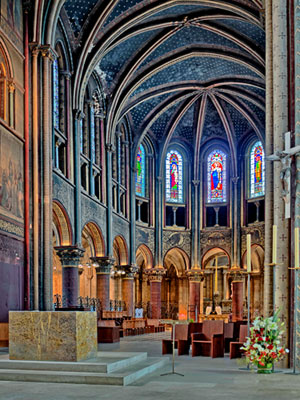 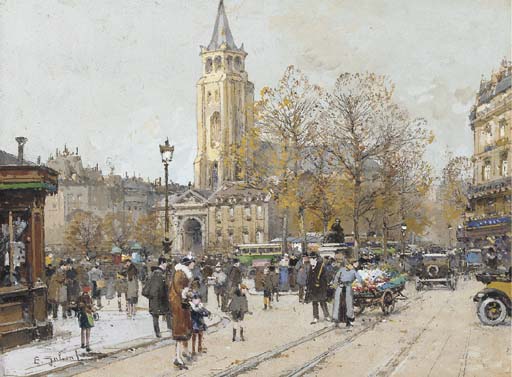 David
Sheppe says the time is now to
make real progress in protecting and preserving the church. "A
small group of interested people formed the American Friends to help
save the church, " says David. "We recognized early on that the
church had a significant impact on Americans who traveled to Paris
(including servicemen from WWII), and on world culture more generally,
and that this was in danger of being lost if some action was not taken."
The current campaign is a natural
outgrowth of the successful Adopt a
St-Germain Star campaign
launched in France last year. "It enables small donors to
participate and to see the tangible results of their effort and
generosity," David notes. "Our partnering French foundation has a
contract with the city of Paris regarding the restoration, which is
audited and supervised. The board of the American Friends is
composed of recognizable and reputable people, and though fundraising
is not the profession any of them has chosen, they have crafted a way
for donors ~ through Adopt a Star ~ to validate their own donation via
computer records and actually locate and see it in person."
With the restoration underway, the
church remains open for worshippers and visitors at all times; it is a
working church with a vibrant parish to support. Visitors today
will see certain areas roped off (and thus inaccessible) due to current
and ongoing works, but these areas ar opened as tasks are completed and
the restoration process moves to other areas of the church.
Visitors can see what has been restored, what is being restored, and
what remains to be restored. Subject to funding (85% of which
must come from private funds), the restoration is due to be finished in
early 2021.
American Friends for the
Preservation of Saint Germain des Prés is a 501(c)(3)
non-profit organization working to fund the restoration of Paris'
oldest church,
garnering donations in the pursuit of preserving history. The organization’s mission is to foster an appreciation for French culture and arts among the public in the United States. It will achieve this, in part, by participating in the restoration of the Church of Saint Germain des Prés so it may continue to serve its parishioners and welcome the nearly 700,000 visitors each year from all over the world who come to see and be inspired by its unparalleled beauty. Saint Germain des Prés' history and beauty touch the lives of Parisians and Americans alike. America’s passion for this monument's eclectic and rich heritage made the formation of the foundation possible. There are more than 800 stars available! Your donation will directly impact the preservation of this historic structure and its beautiful celestial ceiling.Our need is to fund the restoration of the Transept (2017) and the Nave (2018), including their ceilings, which show a total of 3,000 stars. Once your donation is received and you've chosen your star, it will be illuminated on our interactive map. Visitors to the map will see your name appear when they hover over your star. Painting above by Eugène Galien Laloue Contact the American Friends of Saint-Germain de Prés: Carol Donohue, Foundation Administrator American Friends for the Preservation of Saint Germain des Prés Inc Phone: 1.410 543-2126 Fax: 1.410 543-2417
DISCLAIMER: You have received this newsletter because your email address is on our Opt-In mailing list, i.e., you have requested to receive FRANCE On Your Own ©. If you would like to discontinue receipt of this newsletter, please send an email to publisher@franceonyourown.com with "unsubscribe" on the Subject line. Unless indicated otherwise, photos, graphics, artwork and text in the FRANCE On Your Own © newsletter are all the property of Cold Spring Press and FRANCE On Your Own © and cannot be copied, duplicated or used in any manner by anyone without the express written permission of Cold Spring Press. FRANCE On Your Own © is published online by Cold Spring Press, P O Box 26098, San Diego, California 92196-0098. This publication is copyrighted and no portions of the text, artwork, graphics or photographs may be reproduced or distributed in any form or by any means or stored in a database or retrieval system without the written permission of the Publisher. For more information about FRANCE On Your Own ©, visit our web site at http://www.franceonyourown.com. Recommendations made in this newsletter are based upon the personal experiences of the Publishers or contributing writers solely to provide information to subscribers. Cold Spring Press and FRANCE On Your Own © make no endorsements nor are any guarantees or promises of satisfaction given or implied. Any and all information is correct to the best of our knowledge, and the Publishers accept no responsibility for errors and/or omissions. The responsibility lies entirely with the traveler to obtain current information regarding accommodations, availability, schedules, prices, reservations, or any other pertinent details. We do not guarantee the historical accuracy of the contents of articles in this newsletter. Historical accuracy is dependent upon one's sources of information -- and contradictions often exist among those sources. Links to other web sites or email addresses are provided for informational purposes only and do not imply any guarantees of service or endorsement of any organization or their business practices. FRANCE On Your Own © is electronically transmitted via email. To add your email address to our database for this FREE newsletter, send an email to info@franceonyourown.com, and please put Subscribe in the subject line. We do not share email addresses with any other organization. BACK ISSUES of the print version of FRANCE On Your Own © and Free online back issues are available on our web site at http://www.franceonyourown.com/Archives.htm. ©1997-2018
Cold Spring Press All Rights Reserved
|
|
 previous
page
previous
page |